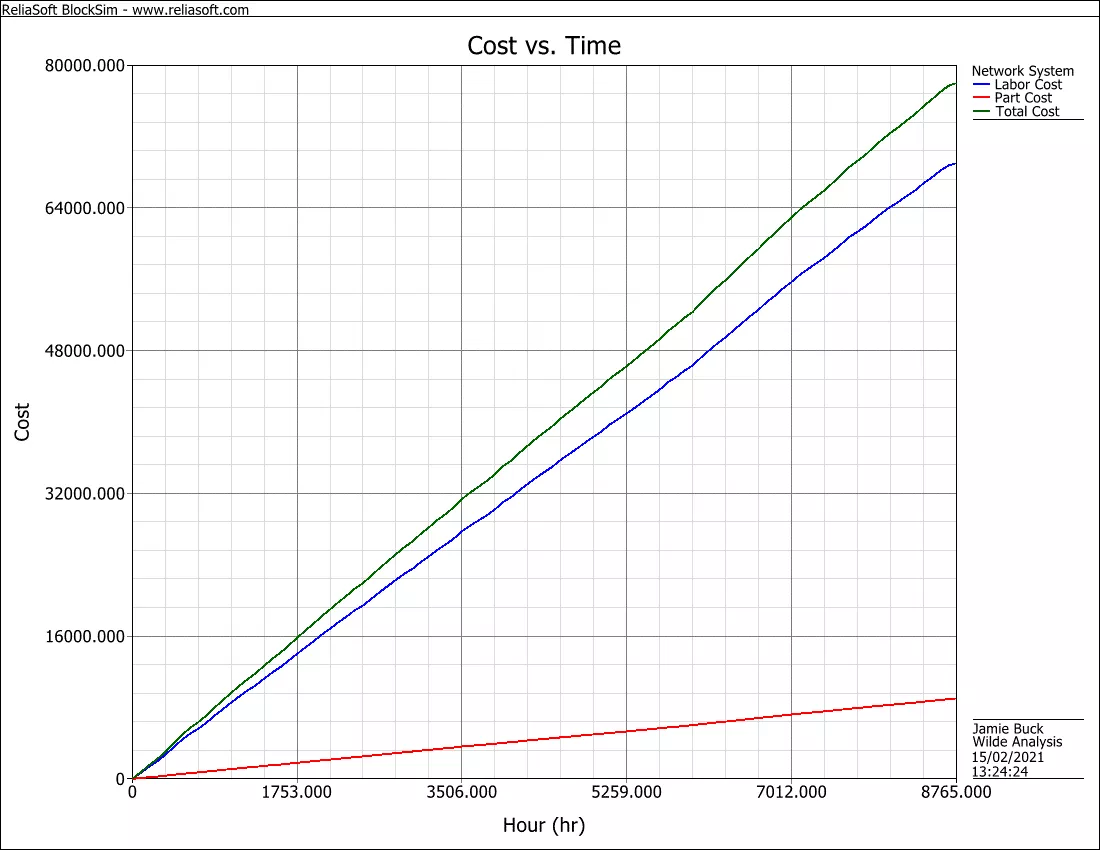Cost Modelling in ReliaSoft BlockSim
March 15th, 2021
Introduction
In this article we will look at how ReliaSoft’s BlockSim, a systems modelling tool, can be used to model costs associated with an asset or product. Cost modelling is a method of estimating the costs associated with a project or product. As with any estimation process, it is important to capture the variability of inputs and to report on the sensitivity of the outputs to this variation, this is where BlockSim can help.
The cost modelling process
- A typical cost modelling process can include the below steps:
- Identify task brief
- Planning and initial research
- Identify and select cost model approach and type
- Identify Analogous Data
- Define model structure (Work Breakdown Structure and Cost Breakdown Structure)
- Record scope of the model including dependencies, assumptions, risks, exclusions, opportunities (DAREO)
- Create and document cost model (e.g., sources of data / references, cost lines, data maturity assessment, data uncertainty)
- Perform model validation, sensitivity and scenario analysis
- Produce and report cost outputs and conclusions (e.g., three point estimate, cost break down and cost drivers, pre and post risk mitigated costs)
Using ReliaSoft BlockSim
ReliaSoft BlockSim provides a comprehensive platform for system reliability, availability, maintainability and related analyses. It allows you to model the most complex systems and processes using reliability block diagrams (RBDs), fault tree analysis (FTA), or Markov diagrams. Using exact computations or discrete event simulation, BlockSim facilitates a wide variety of analyses for both repairable and non-repairable systems.
ReliaSoft’s BlockSim discrete event simulation enables the tool to calculate a system’s reliability, availability and maintainability through the use of applying probability distributions. Known as ‘Resources’ within the tool, these probability distributions account for variability in the frequency of component failures and repair times. Not only does BlockSim associate costs with component failures and repairs, but these costs do not need to be constant and can also vary according to a probability distribution. This enables BlockSim to be used to build a bottom-up cost model and is particularly suited to through-life cost modeling of a system.
What costs can we model?
An overview of what costs can be associated with a component, or block, in an RBD is given below. This list can be broken down into two key categories, costs associated with a maintenance task and costs associated with the consequence of failure.
Scheduled/Corrective Task
- Additional Costs
- Downtime cost
- Cost per task
- Crew
- Cost per hour
- Cost per incident
- Spare Parts
- Cost per dispensed item
Consequential Costs
- Cost per Failure
- Downtime rate
- Uptime rate
Start simple and remember the basics
It is common in both system reliability modelling and cost modelling to build a simple model first, and then to improve the model and add in detail through iterations. The above costs do not all need to be populated, perhaps only the consequential costs are used in the first iteration. It is here where it is crucial to document the model and record where costs are accounted for. This avoids introducing mistakes causing over or underestimates. ReliaSoft BlockSim is built on a database structure and so data can be associated with the cost distribution resources detailing what is in and out of scope. The tool can also store documents such as word and excel files for additional information.
Building in complexity
In addition to system’s reliability, availability and maintainability analysis ReliaSoft BlockSim can be used to perform throughput analysis, to calculate how much product can be produced per unit time. Cost information can then be associated with the throughput to calculate revenue per unit produced. A revenue can also just be associated with a system’s uptime.
Finally, it may be necessary to include system level costs e.g., regulatory fines for a system failure. These can either be added as a cost per system downing event or as a cost per system downtime.
Sharing your result
All this cost data can then be reported at the system level as lost opportunity costs, system running costs and total revenue generated. The BlockSim results data can be interrogated further to identify key cost drivers, parts cost, crew cost, maintenance cost and more. As the simulation analysis is run for simulation duration, perhaps 10 years, it can be used to report results at a reoccurring point in time, perhaps 1 year. This data can then be used to calculate annual running costs, identify high-cost years or to account for inflation. The individual cost information from each of the discrete event simulations can also be recorded to produce a total cost probability plot and so convey cost uncertainty.
Summary
In this article we discussed the basics of cost modelling and how this technique can be used within the reliability engineering space. We then showed how ReliaSoft BlockSim can be used to perform cost modelling, taking into account various operational and maintenance costs.
How we can help
Contact us on +44 (0) 333 996 9930 or email: info@wildeanalysis.co.uk to discuss your specific needs.
